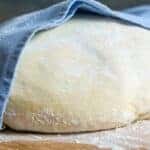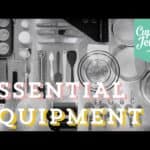Chances are you didn’t realize that buying mixing bowls even needed a guide, but here you are reading my Mixing Bowl Buying Guide. After you purchase your mixing bowls, make sure you are picking the right bowls for the job. If you are looking for the best mixing bowls for bread making, we have a recommendation for you!
First, establish a price point. Bowls can range from under $5 to over $100. Size(s) are also important based on their primary purpose, the volume of food they need to handle and how much storage space is available when they are out of use.
However, a short wide bowl is good for salads and a bowl with taller sides and a narrow base is best for batter and dough. Are you in this for functionality or do you prefer something more aesthetically pleasing and decorative?
Lastly, and most importantly, what type of material is needed for the type of cooking being done? No clue? You are in luck, below are the pros and cons of the major materials for your reading pleasure.
Stainless Steel Mixing Bowl Buying Guide
Pros: Stainless steel is virtually impossible to break, is cheap, lasts an eternity, can be used as a double boiler, lightweight. The majority of stainless is also non-reactive, which is a major benefit for not having unwanted flavors enter your food.
Cons: Metal gets really HOT! It can also get little knicks when whisking or using any type of metal instrument. It isn’t the prettiest of bowls if that is what is important to you and also dent easily. It’s a little plain…
Plastic Mixing Bowl Buying Guide
Pros: Plastic is lightweight, microwave safe, easily transportable, shatter proof and microwave safe. If you take pictures of your food, for Instagram or otherwise, is also non-glare, which is nice.
Cons: Plastic is a reactive material and can melt, warp and generally changes shape over the years. It will need to be replaced every so often. It can also easily become discolored if white. Think tomato sauce.
Ceramic Mixing Bowl Buying Guide
Pros: Ceramic bowls can double as a serving dishes, are heavy, decorative and potentially also non-glare for photos. They are microwave and oven safe and also non-reactive. A winning bowl, right???
Cons: But ceramic is also super heavy, generally more expensive and the biggy… they break and chip easily. I have a set I love and have chipped them just catching it on the corner of the cabinet trying to put them away. Because they aren’t very popular due to these reasons, they are also a little harder to find.
Glass Mixing Bowls Buying Guide
Pros: Glass can also double as serving dish, is non-reactive, temperature resistant (if tempered) and sturdy for those heavy duty projects.
Cons: Being heavy and sturdy is also a con, although not as breakable, the slippery surface does not grip to some foods. It is not ideal for beating egg whites, for example.
Copper Mixing Bowl Buying Guide
Pros: The main benefit to copper is that is great for whipping egg whites. It has the added bonus of being pretty.
Cons: They are very expensive, reactive and require a lot of TLC. Even if you don’t use them, they’ll need to be polished.
Other Considerations
- Do you want pour spouts? I have never had an issue with needing a pour spout, but some people swear by them.
- Would you like lids for storage or transportation? You can always cover your mixing bowl with a temporary topper- plastic wrap or aluminum foil. Keep in mind aluminum foil is reactive and will have the same effects as a reactive bowl.
- Do you prefer non-skid bottoms? Quick tip- you can always wrap a kitchen towel around the bottom of any bowl or set it on a silicone trivet to prevent skidding.
- Do you want a grip or handle? Now that you have your list of wants and needs, you can purchase the mixing bowls of your dreams!
Was this helpful?
Hi there! I’m a food enthusiast and journalist, and I have a real passion for food that goes beyond the kitchen. I love my dream job and I’m lucky enough to be able to share my knowledge with readers of several large media outlets. My specialty is writing engaging food-related content, and I take pride in being able to connect with my audience. I’m known for my creativity in the kitchen, and I’m confident that I can be the perfect guide for anyone looking to take their culinary journey to the next level.








